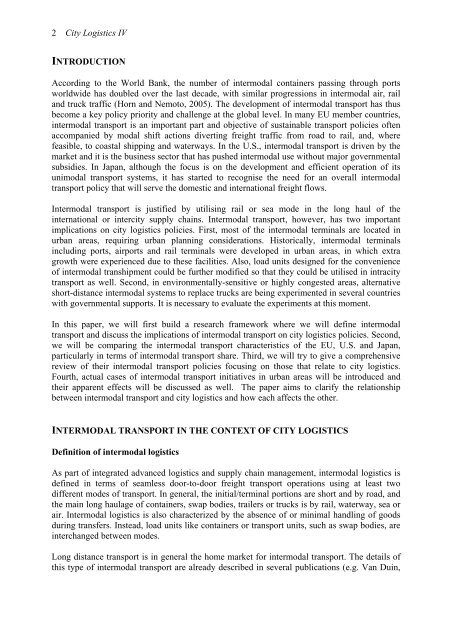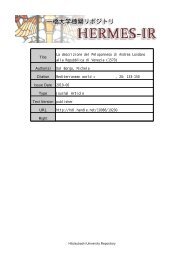intermodal transport and city logistics policies - HERMES-IR
intermodal transport and city logistics policies - HERMES-IR
intermodal transport and city logistics policies - HERMES-IR
You also want an ePaper? Increase the reach of your titles
YUMPU automatically turns print PDFs into web optimized ePapers that Google loves.
2 City Logistics IV<br />
INTRODUCTION<br />
According to the World Bank, the number of <strong>intermodal</strong> containers passing through ports<br />
worldwide has doubled over the last decade, with similar progressions in <strong>intermodal</strong> air, rail<br />
<strong>and</strong> truck traffic (Horn <strong>and</strong> Nemoto, 2005). The development of <strong>intermodal</strong> <strong>transport</strong> has thus<br />
become a key policy priority <strong>and</strong> challenge at the global level. In many EU member countries,<br />
<strong>intermodal</strong> <strong>transport</strong> is an important part <strong>and</strong> objective of sustainable <strong>transport</strong> <strong>policies</strong> often<br />
accompanied by modal shift actions diverting freight traffic from road to rail, <strong>and</strong>, where<br />
feasible, to coastal shipping <strong>and</strong> waterways. In the U.S., <strong>intermodal</strong> <strong>transport</strong> is driven by the<br />
market <strong>and</strong> it is the business sector that has pushed <strong>intermodal</strong> use without major governmental<br />
subsidies. In Japan, although the focus is on the development <strong>and</strong> efficient operation of its<br />
unimodal <strong>transport</strong> systems, it has started to recognise the need for an overall <strong>intermodal</strong><br />
<strong>transport</strong> policy that will serve the domestic <strong>and</strong> international freight flows.<br />
Intermodal <strong>transport</strong> is justified by utilising rail or sea mode in the long haul of the<br />
international or inter<strong>city</strong> supply chains. Intermodal <strong>transport</strong>, however, has two important<br />
implications on <strong>city</strong> <strong>logistics</strong> <strong>policies</strong>. First, most of the <strong>intermodal</strong> terminals are located in<br />
urban areas, requiring urban planning considerations. Historically, <strong>intermodal</strong> terminals<br />
including ports, airports <strong>and</strong> rail terminals were developed in urban areas, in which extra<br />
growth were experienced due to these facilities. Also, load units designed for the convenience<br />
of <strong>intermodal</strong> transhipment could be further modified so that they could be utilised in intra<strong>city</strong><br />
<strong>transport</strong> as well. Second, in environmentally-sensitive or highly congested areas, alternative<br />
short-distance <strong>intermodal</strong> systems to replace trucks are being experimented in several countries<br />
with governmental supports. It is necessary to evaluate the experiments at this moment.<br />
In this paper, we will first build a research framework where we will define <strong>intermodal</strong><br />
<strong>transport</strong> <strong>and</strong> discuss the implications of <strong>intermodal</strong> <strong>transport</strong> on <strong>city</strong> <strong>logistics</strong> <strong>policies</strong>. Second,<br />
we will be comparing the <strong>intermodal</strong> <strong>transport</strong> characteristics of the EU, U.S. <strong>and</strong> Japan,<br />
particularly in terms of <strong>intermodal</strong> <strong>transport</strong> share. Third, we will try to give a comprehensive<br />
review of their <strong>intermodal</strong> <strong>transport</strong> <strong>policies</strong> focusing on those that relate to <strong>city</strong> <strong>logistics</strong>.<br />
Fourth, actual cases of <strong>intermodal</strong> <strong>transport</strong> initiatives in urban areas will be introduced <strong>and</strong><br />
their apparent effects will be discussed as well. The paper aims to clarify the relationship<br />
between <strong>intermodal</strong> <strong>transport</strong> <strong>and</strong> <strong>city</strong> <strong>logistics</strong> <strong>and</strong> how each affects the other.<br />
INTERMODAL TRANSPORT IN THE CONTEXT OF CITY LOGISTICS<br />
Definition of <strong>intermodal</strong> <strong>logistics</strong><br />
As part of integrated advanced <strong>logistics</strong> <strong>and</strong> supply chain management, <strong>intermodal</strong> <strong>logistics</strong> is<br />
defined in terms of seamless door-to-door freight <strong>transport</strong> operations using at least two<br />
different modes of <strong>transport</strong>. In general, the initial/terminal portions are short <strong>and</strong> by road, <strong>and</strong><br />
the main long haulage of containers, swap bodies, trailers or trucks is by rail, waterway, sea or<br />
air. Intermodal <strong>logistics</strong> is also characterized by the absence of or minimal h<strong>and</strong>ling of goods<br />
during transfers. Instead, load units like containers or <strong>transport</strong> units, such as swap bodies, are<br />
interchanged between modes.<br />
Long distance <strong>transport</strong> is in general the home market for <strong>intermodal</strong> <strong>transport</strong>. The details of<br />
this type of <strong>intermodal</strong> <strong>transport</strong> are already described in several publications (e.g. Van Duin,










